Immigration control remains a challenge for the United States and many other nations around the world. While some of the leading immigration issues vary according to the times, other issues are perennial until a suitable solution is found. Knowing exactly who is being granted entry to a nation is one of the preeminent problems today, and it has become vastly more important with the global spread of extremism and terrorism. Some of the tools used to mitigate this problem have changed very little over the centuries (e.g., walls, fences, passports and border guards), but as technology progresses, we have found new means to enforce laws and to make existing precautions more potent. Biometrics has become the most powerful, and perhaps most discussed, implement of the last few decades to better organize and strengthen immigration control. This article will explore current and proposed biometric collection programs, state-of-the-art modalities, devices that might be leveraged, and possible advantages and obstacles that must be overcome to create a balanced and reliable immigration system for the future.
Although biometrics is a modern term, elements of what we consider to be biometrics have been in use for far longer in the quest for a robust immigration control system. What is often called “facial recognition” today has been in use since the beginning of human civilization and is used by almost everyone on a daily basis to recognize friends, acquaintances and enemies. By extension, photography, since its invention, has provided a means of storing a person’s facial image in travel documents, ID cards and criminal databases for future authentication. The newest frontier in facial recognition is the use of automated systems to identify persons from stored imagery data to streamline identification procedures.
While still several years off, there appears to be the promise of using automated systems to correctly identify a person without the need for close scrutiny from a customs official, which should greatly lower wait times at border crossings or ports of entry. Facial recognition using sophisticated computers and software is still very much an imperfect science. Almost any individual can compare a photograph to a person’s face with some degree of accuracy, but computers often have difficulty unless the images are captured under very favorable conditions. While it is a difficult task to covertly perform facial recognition in busy environments, such as airports, overt collection will continue to improve because of the standardization and control of the immediate collection environment. High-resolution cameras are needed to provide images with enough quality to aid in identification. For covert collection, movement of a subject can interfere with the image quality; therefore, the systems need to be able to take motion stills and have algorithms to recognize subjects at angles other than head-
on. Furthermore, facial recognition is the most easily fooled, or “spoofed,” means of identification. Obstructions, such as facial hair, eyeglasses and headwear, can prevent the recognition of the full facial structure of a person, hence the great advantage of overt collection done with the assistance of a collector and participant. Despite its current shortcomings, automated facial recognition, both overt and covert, will only become a more effective central technology in the future of immigration biometric systems.
To a lesser extent than facial recognition, fingerprint capturing has also been a useful tool in immigration control for several decades. Combined with a photograph of a person’s face, the inclusion of a fingerprint on passports or other documents has long been recognized as an effective means for accurately verifying identity. Fingerprinting became understood and utilized as a unique identifier in the late 19th century, and the method of capture has progressed from ink prints to the use of live-scan technology to improve the speed and convenience of collecting data. As a means of recognition, fingerprinting is both accurate and reliable and works best when used in conjunction with other modalities, such as facial recognition or iris scans. Many passports and identification cards that are issued today include a fingerprint scan imbedded in a chip to provide a record for comparison when an individual’s fingerprints are captured using live-scan systems.
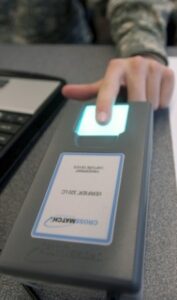
Soldiers learn how to use the Crossmatch 300, a fingerprint scanning device that is part of the biometrics automated tool-set. (U.S. Army photo by Staff Sgt. Lewis Hillburn/Released)
Iris scanning was developed as an identification technology in the 1990s and rapidly expanded in the post-9/11 era to become a sort of gold standard as a biometrics modality. The human iris has extremely complex and delicate patterns that are readily visible and change very little, if at all, during a person’s life. The development of algorithms to chart and record these patterns and readily interpret them to identify an individual has progressed to the level that these systems are extremely fast, efficient and accurate.
Despite these advantages, iris scanners are generally more costly than older forms of biometrics systems, such as fingerprinting, and they require the subject to be within a few meters of the scanning machine. Owing to the great advantages of iris recognition, systems are being widely tested and installed at ports of entry, especially airports, to provide speedy and extremely accurate identification.
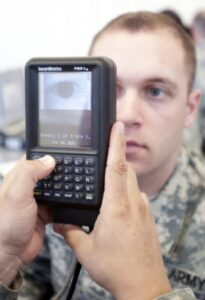
Pfc. Jason McCune sits while his iris is scanned during a biometrics class. (U.S. Army photo by Staff Sgt. Lewis Hillburn/Released)
Dozens of countries around the world have already embraced biometric passports as a fundamental element of improved security. These passports use contactless smart card technology by embedding a microprocessor chip somewhere within the passport booklet that stores fingerprint, facial and/or iris data, depending on the standards adopted by the issuing nation. Among countries using biometric passports are the United States, all nations in the European Union, Russia, Australia, Brazil, Argentina, the People’s Republic of China and many others. Some nations, such as India, have announced the intention of providing biometric passports to its citizens. In the United States, the US-VISIT program was developed to collect biometric data, particularly photographs and 10-print fingerprint scans, from individuals visiting the country to check the data against a database of illegal immigrants, terrorists and criminals. Individuals who are watch-listed as possibly being a risk can be tracked and recognized at ports. This responsibility is now handled by the Office of Biometric Identity Management (OBIM). Similar programs were adopted by other nations such as Japan (J-VIS) and South Korea (ROK-VISIT) to manage access to their borders as well.
Development continues to build on the successes of current programs, mitigating limitations and streamlining processes to efficiently handle the volume of visitors encountered at ports of entry without sacrificing accuracy. The Department of Homeland Security (DHS) has established a testing facility to replicate real-world conditions in order to assess the effectiveness of iris scanning and facial recognition systems and how to best deploy the systems to track entries and departures from the country through major airports. This effort is not only to improve screening times and accuracy but also to electronically track individuals to ensure that they have left the country when their visas expire. [1]
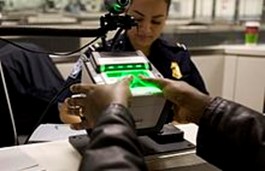
A person using the US-VISIT scanner at a customs check point. (Courtesy of Wikipedia/Released)
Addressing the drawbacks of the current technologies in use is one of the most important parts of the equation. Research is ongoing to lessen or eliminate the disadvantages of certain systems and to offer greater functionality in challenging environments. For instance, the DoD has invested in research projects, such as one at Carnegie-Mellon University that is attempting to create a single system that can perform both facial recognition and iris scanning simultaneously at distances of up to 12 meters. Benefits would include faster processing of people in queues and greater stand-off for security personnel who might have to confront dangerous subjects attempting to enter the country. [2]
U.S. Customs is also preparing to introduce biometric technology to secure border crossings with Mexico, specifically using facial recognition systems to track individuals exiting the country. This type of application of automated biometric systems will be a particular challenge owing to the conditions often encountered at border crossings: moving traffic, obstructions such as windscreens and window tinting, and long lines. Development of a robust system that can accomplish these tasks reliably in adverse conditions would be a further benefit for applications in other challenging environments. [3]
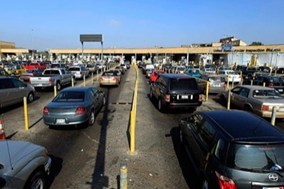
Lines of cars waiting at the Mexico/United States border crossing. (Courtesy of Reuters/Released)
Elsewhere, Australia has begun implementing e-Gate systems in its major airports to track individuals entering and exiting the country. The need for increased security came into focus in June 2014 when reports of possible issues in the Australian immigration tracking system allowed a convicted terrorist to leave the country. The e-Gate systems use biographic data such as name, address and birthdate coupled with a live-scan fingerprint capture to track an individual. Eventually, Australian Customs intends to apply facial recognition technology along with the e-Gates to further fortify their biometrics tracking efforts. [4]

Photo of the e-GATE system at the London Heathrow Air-port in Terminal 4. (Courtesy of Wikipedia/Released)
Malaysia’s immigration department is also planning to introduce a comprehensive biometric system to aid in managing ingress and egress of visitors. Malaysia planned on introducing this system by the end of 2014, with specific aims at limiting drug smuggling, human trafficking, freedom of movement for terrorists, and to possibly help with unforeseen crises such as Malaysian Air Lines flight MH370, which went missing 8 March 2014 under suspicious circumstances. Iris scanning and facial recognition technology will be employed to identify passengers and visitors at airports to complement existing procedures and abolish loopholes. These updates will also be accompanied by other security precautions, such as integrating records with Interpol databases for stolen or lost travel documents,
improved passport scanning systems, high definition closed-circuit security camera and television systems, and improved passenger screening. [5]
While the tools to enforce immigration law are becoming more powerful, policy and training must be capable of following suit to ensure that any gaps in the system are addressed. For instance, in the United States, multiple federal agencies such as the DHS, DoD and Department of State (DoS), as well as many of their sub-agencies, have biometric data responsibilities. The necessity of information sharing across these agencies is of paramount importance to assure that not only are all machines and captured data standardized and up-to-date, but that any needed data is also easily accessible for immigration officials. It would be unconscionable if an identified terrorist from a nation, such as Iraq, were granted access into the United States, particularly if this individual’s biometric data was previously cataloged and watch-listed by DoD collection efforts in that nation. Any break in the chain of sharing of data or watch-lists could result in a breach of security and could possibly jeopardize lives.
Policy must also keep pace with developments in immigration. Policy improvement or implementation commonly trails behind events that shed light on some sort of deficiency. Biometric systems, when properly employed, provide a reliable means of identifying individuals who might have illegal intentions, but knowing what to do with those individuals can be just as important. If an individual is caught attempting to enter the United States illegally, are there proper regulations in place that give clear direction on how they should be handled? The answer is sometimes no. For instance, in spring of 2014, children from Central America who illegally entered the United States to unite with parents who had also illegally entered and stayed in the United States were sent to live with those parents rather than being deported. Although the law allows for the children to remain in the United States to protect them rather than deporting them as adults would be, this apparent contradiction caused Judge Andrew S. Haden to state, “The DHS is rewarding criminal conduct instead of enforcing the current laws. More troubling, the DHS is encouraging parents to seriously jeopardize the safety of their children.” [6]
Lastly, training must also be sufficiently available and implemented to avoid costly mistakes. The best automated biometric systems, progressive strategies and policies put in place can be meaningless if those responsible fail to use the systems in the proper manner or apply appropriate policy accordingly. While biometric systems are becoming more complex and automated, training will need to become more intense and well rounded to guarantee that the data collected is accurate and shared in a timely and efficient manner following the procedures set in place.
Though challenges with immigration systems and enforcement will always remain and change with the times, biometric systems will continue to evolve to help mitigate and anticipate many of the difficulties. Once established, identity dominance in the field of immigration will allow for even greater accuracy of recognition, documentation and enforcement of the law. These efforts will offer the greatest amount of protection to citizens, while ensuring that immigrants and visitors are treated fairly.
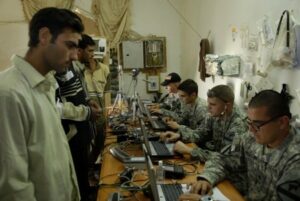
U.S. Soldiers of Headquarters Company, 2nd Battalion, 8th Cavalry Regiment, 1st Brigade Combat Team, 1st Cavalry Division use the Biometrics Automated Tool Set system. (Courtesy of DoD/Released)
References:
[1] http://goo.gl/IJSytY
[2] http://goo.gl/JpEVVj
[3] http://goo.gl/1Hdr3K
[4] http://goo.gl/y8Ec2g
[5] http://goo.gl/U9gljH
[6] http://goo.gl/3VmrFU
About the Author:
Mr. Christopher Daub is a biometrics subject matter expert who worked for Northrop Grumman Corporation as a business development representative and analyst. He has seven years of military and private industry experience in military intelligence. Prior to his current position, Mr. Daub spent four years at the National Ground Intelligence Center in Charlottesville, VA as a drilling reservist and contracting subject matter expert on IEDs and biometrics analysis. He holds a B.A. in Political Science from Indiana University – Bloomington.


